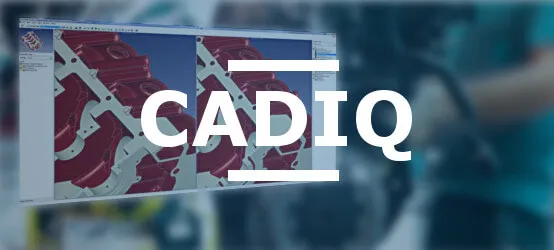In the modern manufacturing industry, a design error can cost millions of euros in production delays, rework, and defects in finished products. CAD model validation represents a major strategic challenge today to ensure the integrity of digital data throughout the development and manufacturing cycle. At the heart of this issue is PMI (Product Manufacturing Information), the digital passport of the product containing all specifications necessary for its manufacturing.
According to a recent study, more than 42% of problems encountered in manufacturing are directly related to errors or inaccuracies in CAD models. These defects, often invisible to the naked eye, can seriously compromise the quality, functionality, and compliance of products, particularly in demanding sectors such as aerospace, automotive, or medical.
Table of contents
- The challenges of CAD model integrity
- Understanding PMI (Product Manufacturing Information)
- CAD model validation methodologies
- Qualification process in a PLM environment
- The CADIQ solution for CAD qualification and comparison
- Case studies and industrial applications
The challenges of CAD model integrity
The increasing complexity of manufactured products comes with an exponential increase in CAD data to manage and validate. This evolution creates new challenges for engineering and production teams, particularly in terms of digital model integrity.
Industrial risks of non-validated CAD models
A defective CAD model can generate cascading consequences throughout the industrial value chain. These impacts manifest at several levels:
- Production delays due to design revisions
- Increased costs related to late modifications
- Manufacturing problems generating waste
- Difficulties in assembly and component integration
- Non-compliance with regulatory requirements
These risks are particularly critical in multi-CAD environments, where data exchanges between different systems can introduce subtle but significant geometric errors. Interoperability between systems remains a major challenge, with information losses of up to 14% during a simple format conversion.
Critical validation points
To ensure the integrity of a CAD model, three fundamental aspects must be systematically validated:
| Aspect | Control points | Potential impact |
|---|---|---|
| Geometric integrity | Degenerate faces, free edges, invalid volumes | Machining failures, analysis problems |
| Annotation consistency | Incomplete PMI, missing references | Erroneous interpretation of specifications |
| Process compatibility | Non-machinable geometries, sharp angles | Inability to manufacture conformably |
Early detection of these issues is essential to prevent their propagation in the digital chain. A structured validation approach allows identification and correction of these defects before they reach critical phases of product development.
Understanding PMI (Product Manufacturing Information)
PMI constitutes the set of non-geometric information necessary for the complete definition of a manufactured product. It represents the fundamental transition from a definition based on 2D drawings to a fully three-dimensional digital model.
In-depth definition of PMI
Product Manufacturing Information (PMI) encompasses several types of semantic annotations that define functional and manufacturing requirements directly in the 3D model:
- Dimensional measurements (linear, angular, radial)
- Geometric tolerances (form, orientation, position)
- Surface finishes
- Manufacturing and assembly notes
- Datum references and coordinate systems
- Specific symbols (welding, heat treatment, etc.)
An important distinction exists between graphic PMI (visual representation of annotations) and semantic PMI (structured data interpretable by computer systems). This duality is at the heart of validation issues, as only semantic PMI allows complete automation of downstream processes.
Strategic role of PMI in MBD (Model-Based Definition)
The MBD (Model-Based Definition) approach places the 3D model enriched with PMI as the single technical reference, progressively eliminating traditional 2D drawings. This transition offers considerable advantages:
| Benefit | Description |
|---|---|
| Digital continuity | Smooth data transmission across all systems |
| Reduced interpretation errors | Direct association of specifications to 3D geometry |
| Increased automation | Automatic generation of machining paths and CMM programs |
| Accelerated revisions | Simultaneous update of the model and annotations |
| Global accessibility | Facilitated sharing of technical data across the extended enterprise |
For this approach to be effective, PMI validation is essential. A missing or incorrect annotation can compromise the entire process, making systematic validation indispensable.
Associated standards and norms
PMI implementation relies on international standards that ensure consistency and common interpretation of annotations. The main standards include:
- ASME Y14.41: defines practices for digital product documentation
- ISO 16792: establishes international rules for digital technical documentation
- ISO 10303 (STEP): specifies exchange formats including semantic annotations
- ISO 1101: details geometric tolerances
- QIF (Quality Information Framework): standardizes the exchange of quality data
Compliance with these standards is an essential aspect of CAD model validation, particularly in regulated sectors where data traceability and certification are mandatory.
CAD model validation methodologies
Complete validation of a CAD model with PMI requires a methodical approach covering several dimensions of analysis. Modern techniques combine geometric verifications, semantic analyses, and compliance checks with industrial standards.
Geometric analysis techniques
Geometric analysis constitutes the first level of validation of a CAD model. It allows identification of defects likely to affect the manufacturability and functionality of the final product:
- Surface defect detection: identification of degenerate faces, free edges, and geometric discontinuities
- Topological analysis: verification of model consistency (valid volumes, absence of self-intersections)
- Mass property evaluation: control of inertial characteristics (volume, center of gravity, moments of inertia)
- Critical feature identification: detection of problematic geometries (thin walls, sharp angles, too small radii)
These analyses establish a first level of confidence in the structural integrity of the model. Modern algorithms can detect more than 160 different types of geometric defects, offering comprehensive coverage of potential problems.
PMI validation
PMI annotation validation is a critical step that ensures compliance with manufacturing and inspection requirements. This validation is structured around three main axes:
| Validation type | Elements controlled |
|---|---|
| Semantic integrity | Correct association of annotations to geometries, completeness of references |
| Standards compliance | Respect for symbolization conventions, standard annotation formats |
| Functional consistency | Non-contradiction of specifications, consistent dimension chains |
Advanced PMI validation tools also verify the readability of annotations in saved views, ensuring that all manufacturing information is clearly visible and correctly positioned.
Detection of tooling and manufacturing issues
Beyond purely geometric validation, CAD model analysis must anticipate real manufacturing constraints. This dimension includes detecting potentially problematic features for machining, molding, or assembly processes:
- Undercuts and recesses inaccessible to tools
- Insufficient radii of curvature for standard tools
- Abrupt transitions generating stress concentrations
- Geometries requiring complex machining operations
- Structures too thin to guarantee the required mechanical strength
This validation anticipates manufacturability problems and allows upstream optimization of the model, considerably reducing iterations between design and production.
Qualification process in a PLM environment
Integrating CAD model validation into the PLM (Product Lifecycle Management) workflow is essential to ensure data quality at each stage of the product lifecycle.
Integration of validation in the development cycle
An effective CAD validation strategy is not limited to a one-time check; it is part of a continuous process aligned with product development milestones:
- Conceptual phase: preliminary validation of envelope models and functional volumes
- Detailed design: thorough checks of geometric integrity and PMI
- Manufacturing preparation: verification of manufacturability and production annotations
- Modifications and revisions: comparative evaluation of changes between versions
- Long-term archiving: validation of compliance with preservation formats
Automation of these quality controls establishes systematic validation points, ensuring that only compliant models progress to the next stages of the process.
Revision management and model comparison
In an industrial environment, CAD models constantly evolve to integrate design modifications, functional optimizations, or adaptations to manufacturing constraints. Effective management of these evolutions requires:
| Capability | Benefit |
|---|---|
| Precise identification of modifications | Complete traceability of changes between versions |
| Geometric comparison | Visualization of shape and position differences |
| PMI modification analysis | Tracking of evolutions in technical specifications |
| Mass property validation | Control of the impact of modifications on inertial characteristics |
| Automated documentation | Generation of reports detailing significant changes |
These features ensure control of model evolutions throughout the development cycle, ensuring that each modification is intentional, documented, and validated.
The CADIQ solution for CAD qualification and comparison
Faced with the complex challenges of CAD model validation with PMI, specialized solutions are necessary to ensure the integrity and reliability of technical data. CADIQ stands as a reference in this field, offering a comprehensive and rigorous approach to model qualification.
General presentation of CADIQ
CADIQ is an advanced solution for comparing CAD models of various formats to identify differences in geometric shape, quality, annotations, and PMI views. This solution detects modifications introduced by technical changes, format conversions, or manual remodeling, with unmatched precision and thoroughness.
Designed to integrate into demanding PLM environments, CADIQ uses the native programming interface of each CAD system to maximize the precision and robustness of analyses, without any intermediate conversion that could alter the data.
Main modules of CADIQ
The modular architecture of CADIQ offers flexibility of integration in various industrial environments. The main components include:
- Embedded Launcher: direct integration into the user interface of CAD systems
- Controller: user interface for creating and monitoring batch analysis tasks
- Analyzer: application that analyzes a model via the native CAD system interface
- Viewer: diagnostic interface to quickly identify the location and properties of each defect
- Specific modules: dedicated functionalities for assembly and PMI analysis
This architecture allows parallel and distributed processing, significantly reducing the time needed to analyze a batch of complex models.
Types of supported diagnostics
The analytical power of CADIQ lies in its ability to detect and characterize a wide range of potential problems in CAD models:
| Diagnostic category | Capabilities |
|---|---|
| Integrity diagnostics | More than 167 types of defects detected (degenerate edges, invalid faces, etc.) |
| Comparison diagnostics | More than 130 types of identifiable differences between models |
| PMI diagnostics | Complete validation of semantic and graphic annotations |
| Assembly diagnostics | Verification of structure and relationships between components |
| Simulation diagnostics | Identification of problematic geometries for numerical analysis |
These diagnostics cover all critical aspects of a CAD model, from basic geometric integrity to specific requirements of downstream processes.
Integration with major CAD systems
One of the main strengths of CADIQ lies in its extensive compatibility with the main CAD systems on the market. This multi-CAD approach allows maintaining digital continuity in heterogeneous environments:
- CATIA V5 (versions v5-6r2021 to v5-6r2024)
- NX (versions 2007 to 2406)
- Creo Parametric (versions 8.0 to 11.0)
- Inventor (versions 2023 to 2025)
- SOLIDWORKS (versions 2022 to 2024)
- Solid Edge
- Neutral formats (STEP, IGES, JT, Parasolid, ACIS, QIF, 3D PDF)
This extended compatibility makes CADIQ an ideal solution for companies working in complex multi-CAD ecosystems, where data exchanges between systems are frequent.
Measurable technical advantages
The implementation of CADIQ in a product development process generates tangible and measurable benefits:
- 65% reduction in manufacturing errors related to modeling defects
- Acceleration of validation cycles through batch and parallel processing
- Early detection of compatibility issues between CAD systems
- Comprehensive documentation of differences between model versions
- Continuous improvement of model quality through statistical analysis
- Automatic generation of statistical reports in Excel format
- Intuitive 3D visualization of defects to facilitate their correction
These advantages directly translate into reduced development costs, accelerated time-to-market cycles, and improved final product quality.
Case studies and industrial applications
CAD model validation with PMI addresses specific needs in many industrial sectors, each presenting particular requirements and constraints.
Application sectors
Validation solutions like CADIQ are particularly relevant in sectors where precision and reliability of technical data are critical:
| Sector | Specific challenges | Key benefits |
|---|---|---|
| Aerospace | Compliance with standards, certification, traceability | Comprehensive documentation, rigorous validation |
| Automotive | High volumes, complex supply chain | Automation, batch validation |
| Defense | Data security, compliance with military specifications | Complete traceability, MBD validation |
| Energy | Longevity of installations, regulatory certification | Validation of physical properties, archiving |
| Medical | FDA/CE compliance, complete traceability | Documentation of changes, PMI validation |
In each of these sectors, CAD model validation integrates with existing quality processes, strengthening the reliability of technical data circulating between different stakeholders.
Typical use cases
In industrial practice, several recurring scenarios justify the implementation of rigorous validation processes:
- Validation of translation between CAD formats: Ensuring that no critical information is lost during conversions between systems
- Quality control before model release: Systematically verifying the integrity of models before their transmission to downstream services
- Analysis of design modifications: Precisely identifying changes between versions and evaluating their impact
- Migration of historical data: Validating the conversion of old models to current systems
- Consolidation of component libraries: Ensuring the consistency of sets of standard parts used in multiple products
For each of these use cases, specific methodologies can be implemented, adapting validation criteria to the particular challenges of the context.
Results observed in production
Companies having implemented validation solutions like CADIQ in their processes report concrete results:
- 70% reduction in manufacturing problems related to model defects
- 45% decrease in time devoted to model correction
- Acceleration of time-to-market cycles by 15 to 20%
- Substantial savings related to the reduction of design revisions
- Measurable improvement in the quality of finished products
- Increased standardization of modeling practices
These benefits demonstrate that investment in validation solutions represents a rapid and significant return on investment for manufacturing companies.
Conclusion
CAD model validation with PMI constitutes today an essential pillar of operational excellence in manufacturing industries. Beyond a simple technical verification, it represents a strategic lever to ensure digital continuity, reduce development costs, and accelerate product time-to-market.
Specialized solutions like CADIQ now offer complete coverage of validation needs, from basic geometric integrity to the most complex PMI annotations. Their integration into PLM environments allows automating quality controls at each stage of the development process, ensuring that only reliable and compliant data progresses in the value chain.
In a context where product complexity continues to grow and development cycles accelerate, investing in CAD model validation is no longer an option but a necessity. Companies that excel in this field gain a significant competitive advantage, reducing their deadlines and costs while improving the quality of their products.



